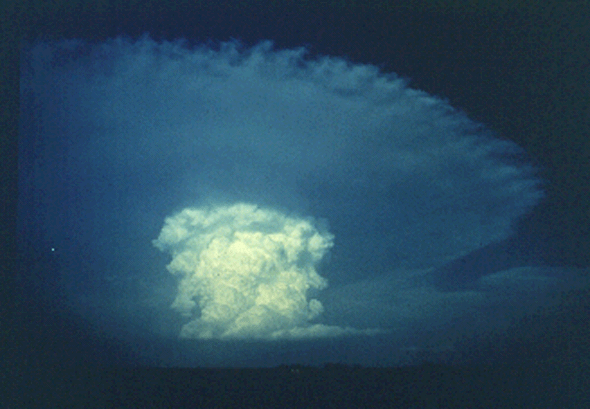
Photograph courtesy of Next Generation Weather Lab
Thunderstorms
Wikipedia defines a thunderstorm as a form of severe weather characterized by the presence of lightning and its attendant thunder. It is often accompanied by copious rainfall, or on occasion, snowfall.
There are a variety of different forms of lightning. Also, observers see lightning differently depending on where they are sitting. Major forms of lightning include forked lightning, streak lightning, ribbon lightning, and chain lightning. There are also rare forms of lightning such as ball lightning, red sprites, blue jets, and elves that have been documented.
o Forked lightning is lightning in which visible branches are present.
o Streak lightning is a bolt that appears to be a single arc shaped line.
o Ribbon lightning is viewed as parallel streaks of light. It is caused when winds separate the strokes of the bolt.
o Chain lightning, or bead lightning, is a bolt that breaks into dotted lines as it fades.
o Ball lightning appears like a glowing red, yellow or orange ball and floats several feet above the ground. It can be as big as a grapefruit in size. No one knows why ball lightning occurs and what it is made of.
o Red sprites are dim, reddish-colored bursts and last for a couple thousandth of a second. They can be numerous kilometers wide. They appear suddenly and there are usually more than one at a time. They can rise above the cloud layer up to 90 kilometers.
o Blue jets are cone-shaped bursts out of the center of a thunderstorm and have speeds up to six thousand kilometers per hour. They rise up to 50 kilometers above the cloud tops and are brighter than red sprites.
o Elves are bursts of light shaped like a doughnut or saucer. They are about four hundred kilometers wide and occur one hundred kilometers above the cloud tops. They last for less than one thousandth of a second and are theorized to be green in color.
Thunderstorms affect smaller areas than other storms, such as hurricanes or winter storms. On average, the typical thunderstorm is 15 miles in diameter and lasts an average of 30 minutes.

Photograph courtesy of
Next Generation
Weather Lab
Some interesting sites to
visit are: